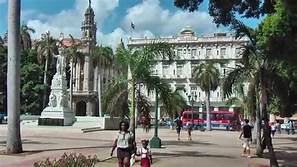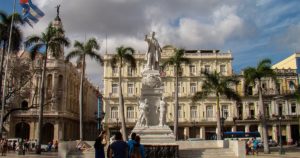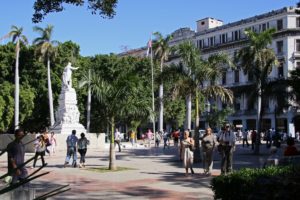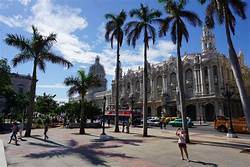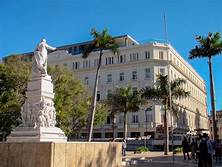EL PARQUE CENTRAL, LA HABANA, CUBA, UN PUNTO DE ENCUENTRO PARA LOS CUBANOS. PHOTOS
El Parque Central es uno de los sitios más conocidos y céntricos de la ciudad de La Habana.
Su construcción fue terminada en el año 1877 luego de que fueron derribadas las murallas que rodeaban la ciudad. Se encuentra ubicado entre las calles Prado, Neptuno, Zulueta y San José, y el bulevar de San Rafael termina frente a este.
Entre los edificios que rodean al parque se encuentran el antiguo Centro Gallego, confiscado por el actual gobierno y convertido en el Gran Teatro de La Habana Alicia Alonso, el Hotel Inglaterra, el Hotel Telégrafo, el Hotel Parque Central, la Manzana de Gómez, el Hotel Plaza y el Museo Nacional de Bellas Artes edificio de Arte Universal. Se encuentra en las cercanías del Capitolio de La Habana y del Parque de la Fraternidad, pertenecientes al municipio Centro Habana, y de la Calle Obispo, el Hotel Sevilla, el Paseo del Prado y del famoso Bar El Floridita pertenecientes al municipio Habana Vieja, encontrándose el propio parque en los límites de ambos municipios.
Fue uno de los parques menos arbolados y de mayor proporción de pavimento. En el año 1905 se colocó en el medio del parque la estatua de José Martí, a instancias de una encuesta popular realizada en el año 1899 por el semanario El Fígaro.
La estatua, confeccionada en mármol de Carrara, es obra de José Villalta de Saavedra y fue la primera que se alzó del Héroe Nacional en Cuba. El monumento consta de pedestal, fuste y estatua.
En lo alto, la estatua del Apóstol, de gran tamaño, se encuentra de pie, vestido con la indumentaria que acostumbraba a usar, y con el brazo derecho en alto, en actitud de hablar al pueblo.
Entre los árboles, muchos centenarios, hay un trazado de senderos que desembocan en pequeñas plazas interiores, adornadas por fuentes y pequeñas esculturas, bordeadas de bancos de piedra y canteros. Los jardines destacan por sus 28 palmas reales en alusión al día del natalicio de Martí.
Se distinguen además ocho tumbas simbólicas en forma de canteros o jardineras, con las cuales se rinde tributo a los estudiantes de Medicina injustamente fusilados por los colonialistas españoles el 27 de noviembre de 1871.
En el fuste se observan varias figuras, una central que representa a la Patria y otras a los costados simbolizando al Ejército Libertador y al pueblo en general, mientras en la parte superior aparece el escudo nacional.
El carácter definitivamente patriótico que adquirió el Parque Central desde la erección de este monumento, lo convirtió durante la época republicana, en el obligado escenario de las más importantes ceremonias oficiales y de los desfiles escolares que se efectuaban cada año el día 28 de enero, en conmemoración del natalicio de Martí, así como de las principales asambleas políticas y las más resonantes protestas populares contra los gobiernos de turno, en especial, las dictaduras de Machado y Batista.
En este período alcanzo resonancia el ultraje cometido en la estatua por marines norteamericanos, que hizo intervenir a las fuerzas policiales, no para detener a los ofensores sino para salvarlos de la indignación popular.
Con antelación, desde 1875, en este lugar había una estatua de la reina española Isabel II, que estuvo colocada hasta que terminó la dominación española sobre Cuba.
PARQUE CENTRAL, PUNTO DE ENCUENTRO
El Parque Central de la Habana es una gran encrucijada citadina, punto de encuentro y referencia para los cubanos.
Luego del triunfo de la Revolución de 1959 en el parque se han realizado disímiles actos políticos de apoyo al gobierno de Fidel Castro. Durante un tiempo, cada 27 de enero en la noche, se realizaba la Marcha de las Antorchas, desde la Universidad de La Habana hasta el Parque Central para conmemorar la víspera del natalicio de José Martí. En la actualidad la mencionada peregrinación solo se realiza hasta la Fragua Martiana como ocurrió en su primera ocasión.
Al sur de la estatua de José Martí se puede ver a diario la famosa “esquina caliente”, donde un grupo de hombres aficionados al béisbol, ríe, grita y discute sobre las estadísticas, las posibilidades de sus equipos de jugar la final de la Serie Nacional de Béisbol y los hábitos de sus jugadores favoritos
En el parque se desarrolla parte de la trama de la obra ‘Chamaco’ (2002), del dramaturgo Abel González Melo.
THE CENTRAL PARK, HAVANA, CUBA, IS A MEETING POINT FOR CUBANS. PHOTOS
Parque Central is one of the most well-known and central places in the city of Havana.
Its construction was completed in 1877 after the walls that surrounded the city was demolished. It is located between Prado, Neptuno, Zulueta, and San José streets, and San Rafael Boulevard ends in front of it.
Among the buildings that surround the park are the old Galician Center, confiscated by the current government and converted into the Alicia Alonso Grand Theater of Havana, the Hotel Inglaterra, the Hotel Telégrafo, the Hotel Parque Central, the Manzana de Gómez, the Hotel Plaza and the National Museum of Fine Arts building of Universal Art. It is located in the vicinity of the Capitol of Havana and the Parque de la Fraternidad, belonging to the Centro Habana municipality, and Calle Obispo, the Hotel Sevilla, the Paseo del Prado, and the famous El Floridita Bar belonging to the Habana Vieja municipality, being the park itself in the limits of both municipalities.
It was one of the least wooded parks and with the highest proportion of pavement. In 1905, the statue of José Martí was placed in the middle of the park, at the request of a popular survey carried out in 1899 by the weekly newspaper El Fígaro.
The statue, made of Carrara marble, is the work of José Villalta de Saavedra and was the first to be erected by the National Heroin Cuba. The monument consists of a pedestal, shaft, and statue.
At the top, the statue of the Apostle, of great size, is standing, dressed in the clothing that he used to wear, and with his right arm raised, in an attitude of speaking to the people.
Among the trees, many of which are centuries old, there is a layout of paths that lead to small interior squares, adorned with fountains and small sculptures, lined with stone benches and flowerbeds. The gardens stand out for their 28 royal palms in allusion to Martí’s birthday.
There are also eight symbolic tombs in the form of flowerbeds or planters, with which tribute is paid to the medical students unjustly shot by the Spanish colonialists on November 27, 1871.
Several figures can be seen on the shaft, a central one representing the Homeland and others on the sides symbolizing the Liberation Army and the people in general, while the national coat of arms appears at the top.
The definitively patriotic character that Central Park acquired since the erection of this monument made it, during the Republican era, the obligatory setting for the most important official ceremonies and school parades that took place every year on January 28, in commemoration of the birth of Martí, as well as the main political assemblies and the most resounding popular protests against the governments of the day, especially the dictatorships of Machado and Batista.
In this period, the outrage committed on the statue by US Marines reached resonance, which made the police forces intervene, not to arrest the offenders but to save them from popular indignation.
In advance, since 1875, in this place, there was a statue of the Spanish Queen Elizabeth II, which was placed until the end of the Spanish domination over Cuba.
CENTRAL PARK, MEETING POINT
Havana’s Central Park is a great city crossroads, a meeting point and reference point for Cubans.
After the triumph of the 1959 Revolution in the park, dissimilar political acts have been carried out in support of the government of Fidel Castro. For a time, every January 27 at night, the March of the Torches was held, from the University of Havana to the Central Park to commemorate the eve of the birth of José Martí. At present, the aforementioned pilgrimage is only carried out as far as the Fragua Martiana, as it happened on its first occasion.
To the south of the statue of José Martí, you can see the famous “hot corner” every day, where a group of men who are fond of baseball laugh, shout and discuss the statistics, the possibilities of their teams playing the final of the Series National Baseball and the habits of your favorite players
Part of the plot of the play ‘Chamaco’ (2002), by playwright Abel González Melo, takes place in the park.
Agencies. Wiki. ParqueCentralHist. Extractos. Excerpts. Internet Photos. Arnoldo Varona. www.TheCubanHistory.com
THE CUBAN HISTORY, HOLLYWOOD.



 EL PARQUE CENTRAL, La Habana, Cuba, un punto de Encuentro para los Cubanos. PHOTOS. * THE CENTRAL PARK, Havana, Cuba, is a meeting point for Cubans. PHOTOS.
EL PARQUE CENTRAL, La Habana, Cuba, un punto de Encuentro para los Cubanos. PHOTOS. * THE CENTRAL PARK, Havana, Cuba, is a meeting point for Cubans. PHOTOS.